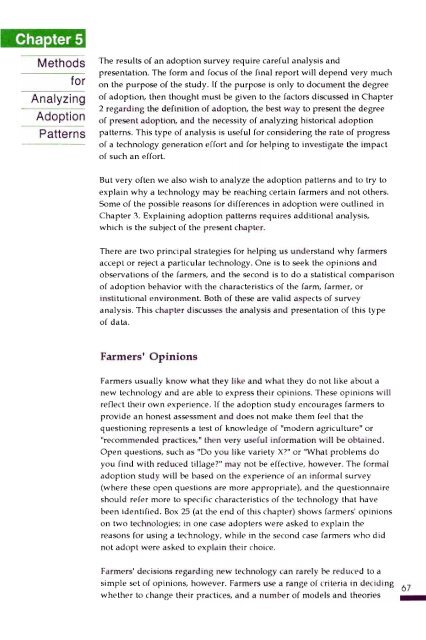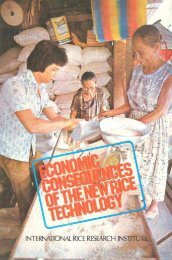The Adoption of Agricultural Technology - Food Security Group
The Adoption of Agricultural Technology - Food Security Group
The Adoption of Agricultural Technology - Food Security Group
Create successful ePaper yourself
Turn your PDF publications into a flip-book with our unique Google optimized e-Paper software.
Cha ter 5MethodsforAnalyzing<strong>Adoption</strong>Patterns<strong>The</strong> results <strong>of</strong> an adoption survey require careful analysis andpresentation. <strong>The</strong> form and focus <strong>of</strong> the final report will depend very muchon the purpose <strong>of</strong> the study. If the purpose is only to document the degree<strong>of</strong> adoption, then thought must be given to the factors discussed in Chapter2 regarding the definition <strong>of</strong> adoption, the best way to present the degree<strong>of</strong> present adoption, and the necessity <strong>of</strong> analyzing historical adoptionpatterns. This type <strong>of</strong> analysis is useful for considering the rate <strong>of</strong> progress<strong>of</strong> a technology generation effort and for helping to investigate the impact<strong>of</strong> such an effort.But very <strong>of</strong>ten we also wish to analyze the adoption patterns and to try toexplain why a technology may be reaching certain farmers and not others.Some <strong>of</strong> the pOSSible reasons for differences in adoption were outlined inChapter 3. Explaining adoption patterns requires additional analysis,which is the subject <strong>of</strong> the present chapter.<strong>The</strong>re are two principal strategies for helping us understand why farmersaccept or reject a particular technology. One is to seek the opinions andobservations <strong>of</strong> the farmers, and the second is to do a statistical comparison<strong>of</strong> adoption behavior with the characteristics <strong>of</strong> the farm, farmer, orinstitutional environment. Both <strong>of</strong> these are valid aspects <strong>of</strong> surveyanalysis. This chapter discusses the analysis and presentation <strong>of</strong> this type<strong>of</strong> data.Farmers' OpinionsFarmers usually know what they like and what they do not like about anew technology and are able to express their opinions. <strong>The</strong>se opinions willreflect their own experience. If the adoption study encourages farmers toproVide an honest assessment and does not make them feel that thequestioning represents a test <strong>of</strong> knowledge <strong>of</strong> "modern agricul ture" or"recommended practices," then very useful information will be obtained.Open questions, such as "Do you like variety X?" or "What problems doyou find with reduced tillage?" may not be effective, however. <strong>The</strong> formaladoption study will be based on the experience <strong>of</strong> an inrormal survey(where these open questions are more appropriate), and the questionnaireshould refer more to speCific characteristics or the technology that havebeen identified. Box 25 (at the end <strong>of</strong> this chapter) shows farmers' opinionson two technologies; in one case adopters were asked to explain thereasons for using a technology, while in the second case rarmers who didnot adopt were asked to explain their choice.Farmers' decisions regarding new technology can rarely be reduced to asimple set or opinions, however. Farmers use a range <strong>of</strong> criteria in decidingwhether to change their practices, and a number or models and theories-67



